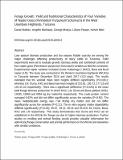| dc.description.abstract | Abstract
Low pasture biomass production and dry seasons fodder scarcity are among the major challenges affecting productivity of dairy cattle in Tanzania. Field experiments were set to evaluate growth, biomass yields and nutritional contents of four napier grass (Pennisetum purpureum Schumach) varieties as feed for ruminants. Experimental napier varieties included Ouma, Kakamega 2 (KK2), Bana and local napier (LN). The study was conducted in the Western Usambara highlands (WUHs) in Tanzania between December 2016 and April 2017 (110 days). The results indicated that the varietal mean stem heights differed significantly (P<0.001); whereby LN, Ouma, KK2 and Bana had mean heights of 210.81, 185.72, 177.15 and 145.44 cm respectively. There was a significant difference (P=0.025) in the mean total forage biomass production in which KK2, LN, Ouma and Bana yielded 16551, 14035, 12868 and 8954 kg dry matter/ha respectively. The crude protein content averaged 9.92% and did not differ significantly across the varieties (P=0.83). The mean metabolizable energy was 7.94 MJ/kg dry matter and did not differ significantly across the varieties (P=0.11). The in vitro organic matter digestibility differed significantly (P=0.03); 65.87, 59.22, 58.33 and 55.41% for Ouma, Bana, KK2 and LN respectively. This study demonstrates that Ouma and KK2 can be established in the WUHs for forage use due to higher biomass production. Further studies on ensiling and animal feeding would provide valuable information for optimizing forage conservation and animal performance in the WUHs and elsewhere with similar conditions. | en_US |

